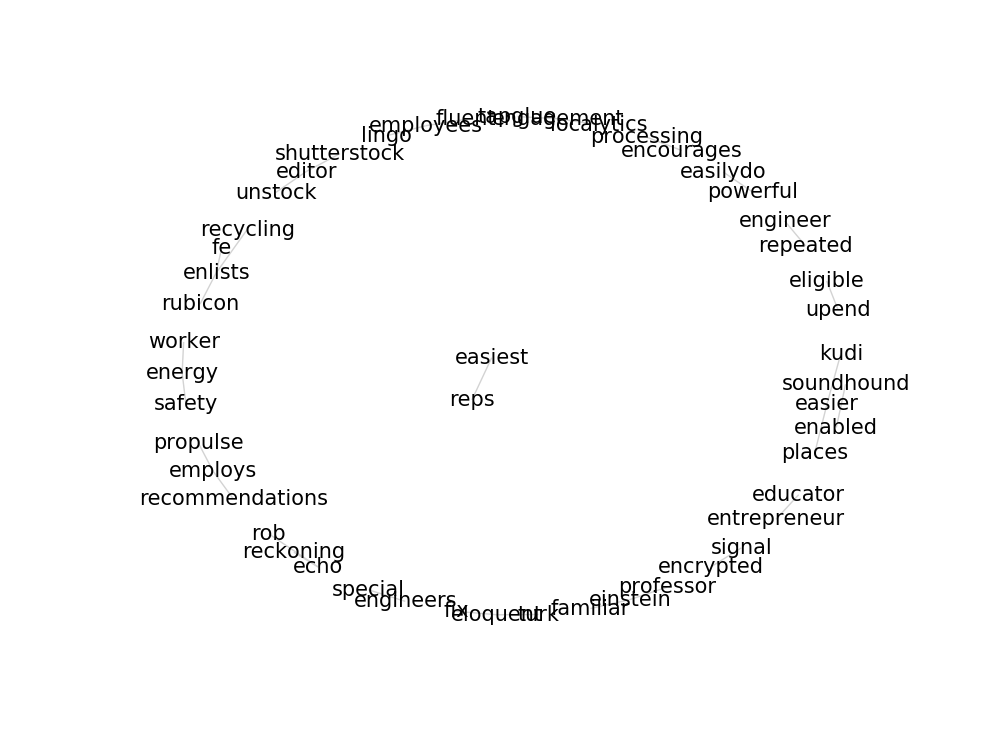techcrunch 뉴스 크롤링
뉴스 기사 목록 수집, Term Document Matrix, Word Cloud, Word network
import requests
import lxml.html
기사 목록 가져오기
url = 'https://techcrunch.com/startups/page/2/'
# 기사 제목에 해당하는 html 구조
# <div> <h2 class=""> <a href="">
def get_tc_list(page):
"""각 page에 있는 기사 제목을 가져온다"""
url = 'https://techcrunch.com/startups/page/{}/'.format(page) # URL 만들기
res = requests.get(url) # 기사 목록
root = lxml.html.fromstring(res.text) # HTML 파싱
titles = root.cssselect('h2 a') # 제목 가져오기
# Generator
for title in titles:
yield title.text
# 1 page 기사 리스트
list(get_tc_list(1))
['83North closes $250M fourth fund focused on European, Israeli\xa0startups',
'London-based Forward Partners closes new £60M fund to invest in startups at idea and Seed\xa0stage',
'CheckRecipient, a London startup that uses machine learning to stop misaddressed emails, raises\xa0$2.7M',
'Instacart VP of operations Mike Swartz has left the\xa0company',
'High school junior launches TagDat, an emoji-based local reviews\xa0app',
'How Winnipeg focused on local strengths to create a tech hub in central\xa0Canada',
'LocusBots can now ‘talk’ to each other and collaborate in\xa0warehouses',
'The TC Disrupt After Parties (and concert!) are going to be off the\xa0hook!',
'TC is taking over Manhattan on\xa0Thursday!',
'This new sentiment index aims to help founders time their\xa0fundraising',
'Spotify trades free-tier album delays for smaller\xa0royalties',
'Pluto AI raises $2.1 million to bring intelligence to water\xa0treatment',
'Vimcar, a Berlin startup that offers hardware and an app to manage company fleets, raises\xa0$5.5M',
'Infiniti launches a startup lab in Toronto to focus on IoT and smart\xa0cities',
'Oscar Health’s Mario Schlosser is coming to Disrupt NY\xa02017',
'Money transfer startup Azimo now lets you send money to a phone\xa0number',
'Amino raises $25 million to match patients with doctors best qualified to help\xa0them',
'Blackstorm Labs and Rakuten launch R Games to build high-fidelity HTML5\xa0games',
'Apple Fellow Rich Page on ‘stealing jobs’ and Chowbotics’ salad-making\xa0robots',
'Author Ryan Holiday talks about the value of stoicism in a high-tech\xa0world']
TQDM
진행 막대(pregress bar)를 보여주는 라이브러리. conda install tqdm.
import tqdm
기사 수집
articles = []
# 30 page 까지
for page in tqdm.tqdm_notebook(range(1, 31)):
articles = articles + list(get_tc_list(page))
len(articles)
600
articles[0]
'83North closes $250M fourth fund focused on European, Israeli\xa0startups'
TDM (Term Document Matrix)
from sklearn.feature_extraction.text import CountVectorizer
cv = CountVectorizer(max_features=2000, stop_words='english')
# max_features : 최대 단어 갯수
# stop_words : 제외할 단어 목록 (english : a, the, of 등을 제외할 단어 내장)
tdm = cv.fit_transform(articles) # make TDM
tdm
<600x2000 sparse matrix of type '<class 'numpy.int64'>'
with 4183 stored elements in Compressed Sparse Row format>
words = cv.get_feature_names() # word list. 한 단어가 컬럼 하나.
words[100:130]
['acquires',
'acquisition',
'acquisitions',
'action',
'ad',
'adam',
'add',
'additional',
'addresses',
'adds',
'adelphic',
'ads',
'adsemble',
'advertising',
'aerial',
'aes',
'affordable',
'africa',
'agent',
'aggregates',
'aging',
'agreed',
'ai',
'aiden',
'aimed',
'aiming',
'aims',
'air',
'airbnb',
'airlines']
count_mat = tdm.sum(axis=0) # column별 합계. 즉, 단어별 사용 횟수
count_mat
matrix([[4, 2, 2, ..., 1, 1, 1]], dtype=int64)
import numpy
count = numpy.squeeze(numpy.asarray(count_mat)) # matrix --> array
count
array([4, 2, 2, ..., 1, 1, 1], dtype=int64)
word_count = list(zip(words, count))
word_count[100:130]
[('acquires', 22),
('acquisition', 3),
('acquisitions', 1),
('action', 1),
('ad', 7),
('adam', 1),
('add', 2),
('additional', 1),
('addresses', 1),
('adds', 7),
('adelphic', 1),
('ads', 4),
('adsemble', 1),
('advertising', 1),
('aerial', 1),
('aes', 1),
('affordable', 4),
('africa', 2),
('agent', 1),
('aggregates', 1),
('aging', 2),
('agreed', 1),
('ai', 24),
('aiden', 1),
('aimed', 2),
('aiming', 1),
('aims', 7),
('air', 1),
('airbnb', 6),
('airlines', 1)]
import operator
word_count = sorted( # 정렬
word_count,
key=operator.itemgetter(1), # 1번째(빈도)를 기준으로
reverse=True) # 내림차순으로
word_count[:30]
[('raises', 85),
('million', 70),
('startup', 67),
('new', 51),
('app', 47),
('startups', 37),
('tech', 29),
('launches', 28),
('platform', 25),
('ai', 24),
('acquires', 22),
('help', 21),
('series', 20),
('wants', 19),
('data', 17),
('mobile', 17),
('service', 17),
('company', 16),
('meetup', 15),
('london', 14),
('media', 14),
('5m', 13),
('founder', 13),
('lets', 13),
('make', 13),
('search', 13),
('online', 12),
('smart', 12),
('social', 12),
('uk', 12)]
WordCloud
Windows (Mac osX 지원 안됨)
- Unofficial Windows Binaries for Python Extension Packages에서 wordcloud-1.3.1-cpXX-cpXXm-win_amdXX.whl를 다운받은 다음, 명령창에서 아래 명령을 실행:
- 자신의 Python 버전과 운영체제 bit에맞게 다운로드
- cd c:\Downloads
- pip install wordcloud-1.3.1-cp35-cp35m-win_amd64.whl
%matplotlib inline
from matplotlib import pyplot
from wordcloud import WordCloud
wc = WordCloud(background_color='white', width=400, height=300)
cloud = wc.generate_from_frequencies(dict(word_count))
pyplot.figure(figsize=(12, 9))
pyplot.imshow(cloud)
pyplot.axis("off")
pyplot.show()

상관 행렬 (correlation matrix)
word_corr = numpy.corrcoef(tdm.todense(), rowvar=0)
word_corr
array([[ 1. , -0.00386403, -0.00386403, ..., -0.00273 ,
-0.00273 , -0.00273 ],
[-0.00386403, 1. , -0.00334448, ..., -0.00236293,
-0.00236293, -0.00236293],
[-0.00386403, -0.00334448, 1. , ..., -0.00236293,
-0.00236293, -0.00236293],
...,
[-0.00273 , -0.00236293, -0.00236293, ..., 1. ,
-0.00166945, -0.00166945],
[-0.00273 , -0.00236293, -0.00236293, ..., -0.00166945,
1. , -0.00166945],
[-0.00273 , -0.00236293, -0.00236293, ..., -0.00166945,
-0.00166945, 1. ]])
edges = []
for i in range(len(words)):
for j in range(i + 1, len(words)):
if (words[i][0] == 'e'): # e로 시작하는 단어들만...
edges.append((words[i], words[j], word_corr[i, j]))
edges = sorted(edges, key=operator.itemgetter(2), reverse=True)
edges = edges[:30]
edges
[('easier', 'kudi', 1.0),
('easier', 'places', 1.0),
('easiest', 'reps', 1.0),
('easilydo', 'powerful', 1.0),
('echo', 'reckoning', 1.0),
('echo', 'rob', 1.0),
('editor', 'shutterstock', 1.0),
('editor', 'unstock', 1.0),
('educator', 'entrepreneur', 1.0),
('einstein', 'familiar', 1.0),
('einstein', 'professor', 1.0),
('eligible', 'upend', 1.0),
('eloquent', 'fix', 1.0),
('eloquent', 'turk', 1.0),
('employees', 'fluent', 1.0),
('employees', 'lingo', 1.0),
('employs', 'propulse', 1.0),
('employs', 'recommendations', 1.0),
('enabled', 'soundhound', 1.0),
('encourages', 'processing', 1.0),
('encrypted', 'signal', 1.0),
('energy', 'safety', 1.0),
('energy', 'worker', 1.0),
('engagement', 'localytics', 1.0),
('engagement', 'tapglue', 1.0),
('engineer', 'repeated', 1.0),
('engineers', 'special', 1.0),
('enlists', 'fe', 1.0),
('enlists', 'recycling', 1.0),
('enlists', 'rubicon', 1.0)]
edge_list = [(word1, word2) for word1, word2, weight in edges]
edge_list
[('easier', 'kudi'),
('easier', 'places'),
('easiest', 'reps'),
('easilydo', 'powerful'),
('echo', 'reckoning'),
('echo', 'rob'),
('editor', 'shutterstock'),
('editor', 'unstock'),
('educator', 'entrepreneur'),
('einstein', 'familiar'),
('einstein', 'professor'),
('eligible', 'upend'),
('eloquent', 'fix'),
('eloquent', 'turk'),
('employees', 'fluent'),
('employees', 'lingo'),
('employs', 'propulse'),
('employs', 'recommendations'),
('enabled', 'soundhound'),
('encourages', 'processing'),
('encrypted', 'signal'),
('energy', 'safety'),
('energy', 'worker'),
('engagement', 'localytics'),
('engagement', 'tapglue'),
('engineer', 'repeated'),
('engineers', 'special'),
('enlists', 'fe'),
('enlists', 'recycling'),
('enlists', 'rubicon')]
weight_list = [weight for word1, word2, weight in edges]
weight_list
[1.0,
1.0,
1.0,
1.0,
1.0,
1.0,
1.0,
1.0,
1.0,
1.0,
1.0,
1.0,
1.0,
1.0,
1.0,
1.0,
1.0,
1.0,
1.0,
1.0,
1.0,
1.0,
1.0,
1.0,
1.0,
1.0,
1.0,
1.0,
1.0,
1.0]
import networkx
G = networkx.Graph()
edge_set = set()
for word1, word2, weight in edges:
G.add_edge(word1, word2, weight=weight)
edge_set.add((word1, word2))
position = networkx.spring_layout(G, k=0.09, iterations=100)
pyplot.figure(figsize=(12, 9))
networkx.draw_networkx_nodes(G, position, node_size=0)
networkx.draw_networkx_edges(G, position, edgelist=edge_list, width=weight_list, edge_color='lightgray')
networkx.draw_networkx_labels(G, position, font_size=15)
pyplot.axis('off')
pyplot.show()

